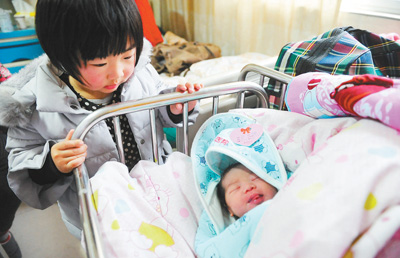


Since China introduced the second-child policy in 2016, the country has been constantly adjusting supporting policies to cope with its results, chinanews.com reported.
Though the number of women in child-bearing age decreased, the number of newborns grew noticeably after the implementation of the universal two-child policy.
In 2016, the number of live births was 18.46 million, the highest level since 2000, in which over 45 percent are second children, up more than 10 percent from 2013.
“China does not lack in population, not in a few decades, not in 100 years,” said Wang Peian, deputy head of the National Health and Family Planning Commission. However, he said that China needs to resolve issues related to the disappearance of China’s demographic dividend, the ultra-low fertility rate, an aging population, and the imbalance of sex ratio at birth.
To tackle them, the country has been constantly strengthening its family planning policy, and the efforts have yielded positive changes. In 2016, the total fertility rate—the average number of children a woman gives birth to during her lifetime—increased to more than 1.7.
“The adjustment of the family planning policy has been well received among Chinese,” said Ma Li, a counselor of the State Council, adding that an aging population also means a more civilized society. He said increasing the birth rate and the proportion of young people in the society are key to boosting vitality and innovation.
Ma said Chinese couples will need at least five years to unleash their fertility desire, predicting that a baby boom will show up in 2017 and 2018. He also emphasized the need to strengthen supporting policies, such as reducing child-rearing costs.
China’s Health and Family Planning Commission said it will increase the number of maternity beds by 89,000 from 2016 to 2020, to help hospitals cope with the demand resulting from the second-child policy.
According to statistics, China allocated 2.91 billion yuan ($440 million) in 2016 to build 45 city-level and 202 county-level maternity and child care institutions across the country, a notably increase from the period between 2011 and 2015.
In 2016, the number of kindergartens reached 240,000, an increase of 59,000 spots compared with 2012. The gross rate of enrollment hit 77.4 percent, up 12.9 percent in five years.
An education guideline issued at the beginning of the year stipulated that education departments across the country should expand pre-school education resources and guarantee full kindergarten enrollment.
In addition, a total of 31 provincial regions have extended maternity leave since the introduction of the two-child policy, a move applauded by new mothers across the country.
A survey released in February indicated that about 60 percent of families having a second child said their sense of happiness has been raised noticeably and 70 percent said they do not regret having a second baby.
 Fire brigade in Shanghai holds group wedding
Fire brigade in Shanghai holds group wedding Tourists enjoy ice sculptures in Datan Town, north China
Tourists enjoy ice sculptures in Datan Town, north China Sunset scenery of Dayan Pagoda in Xi'an
Sunset scenery of Dayan Pagoda in Xi'an Tourists have fun at scenic spot in Nanlong Town, NW China
Tourists have fun at scenic spot in Nanlong Town, NW China Harbin attracts tourists by making best use of ice in winter
Harbin attracts tourists by making best use of ice in winter In pics: FIS Alpine Ski Women's World Cup Slalom
In pics: FIS Alpine Ski Women's World Cup Slalom Black-necked cranes rest at reservoir in Lhunzhub County, Lhasa
Black-necked cranes rest at reservoir in Lhunzhub County, Lhasa China's FAST telescope will be available to foreign scientists in April
China's FAST telescope will be available to foreign scientists in April "She power" plays indispensable role in poverty alleviation
"She power" plays indispensable role in poverty alleviation Top 10 world news events of People's Daily in 2020
Top 10 world news events of People's Daily in 2020 Top 10 China news events of People's Daily in 2020
Top 10 China news events of People's Daily in 2020 Top 10 media buzzwords of 2020
Top 10 media buzzwords of 2020 Year-ender:10 major tourism stories of 2020
Year-ender:10 major tourism stories of 2020 No interference in Venezuelan issues
No interference in Venezuelan issues
 Biz prepares for trade spat
Biz prepares for trade spat
 Broadcasting Continent
Broadcasting Continent Australia wins Chinese CEOs as US loses
Australia wins Chinese CEOs as US loses